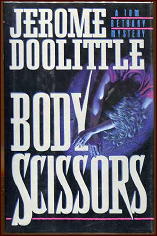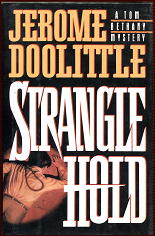FIRST YOU READ, THEN YOU WRITE
by Francis M. Nevins

No sooner did I send off my November column than I learned of another death in October. Norman Sherry, who devoted almost thirty years of his life to researching and writing a 3-volume, 2250-page biography of Graham Greene, died on October 19 at age 91. For Volume One (1989) he received an Edgar from MWA. The New York Review of Books chose Volume Two (1994) as one of the eleven best books of its year. If I have a special fondness for Volume Three (2004), perhaps it’s because I contributed to it a little.
The story of how he came to be Greene’s biographer has been often told. In 1974, the year he turned 70, the man who was perhaps the finest English novelist of the 20th century — and certainly one of the finest crime and espionage novelists ever — was in the market for a biographer and became interested in Sherry, whose previous life of Joseph Conrad Greene had much admired.
The two met for lunch at London’s Savile Club but apparently nothing was decided. They met again and, walking across a busy street, Greene was knocked down by a taxi. “You almost lost your subject,†he said to Sherry. “Not half so bad as losing your biographer,†Sherry replied. That bit of quick wit got him the job. It was the beginning of a decades-long hunt with Sherry the literary detective tracking Greene through Mexico, Cuba, Liberia, Vietnam, Haiti, most if not all of the Third World places in which his quarry had set novels.

The quest was ruinous to Sherry’s health — dysentery, gangrene that cost him fifteen feet of his intestines, the list seems endless — but he carried on. After Greene’s death in 1991 he found himself at odds with his subject’s closest relations, many of whom despise his three volumes. You can find what Greene’s son Francis thought of the books by googling “Graham Greene Norman Sherry,†such as this article from the New York Times, and there are similar critiques elsewhere on the Web.
But there are also extravagant, near-idolatrous comments by others. My own view is that if you want to understand, or at least come as close as humanly possible to understanding, the brilliant, profoundly devious, sex-obsessed alcoholic who wrote like a dark angel and gave us THIS GUN FOR HIRE, BRIGHTON ROCK, THE CONFIDENTIAL AGENT, THE MINISTRY OF FEAR and so many other novels that have nothing to do with crime or espionage, you can’t do without Sherry’s epic biography.
But perhaps I’m biased since, as I said above, I contributed a morsel to Volume Three. After such a buildup I’d be a toad if I didn’t share that morsel here with those who haven’t read the biography, so here goes. Back in 1984 and purely by accident I discovered that James Atlee Phillips, better known as Philip Atlee, author of the Joe Gall espionage novels, had moved to St. Louis County where I lived. Jim was reputed to be an interview-shunning curmudgeon but I took a chance, called him and, to my flabbergastment, was invited to come out to his place for dinner.

After the meal we adjourned to his basement office, and I taped an hour-long conversation with him which was published in Espionage magazine (November 1985). That interview went so well that arrangements were made for me to follow up by interviewing Jim’s younger brother, David Atlee Phillips.
David, who lived in Bethesda, Maryland, had written a novel and one or two nonfiction books but until his retirement a few years before our meeting most of his time had been spent working for the Central Intelligence Agency in Guatemala, Cuba, Mexico, the Dominican Republic, Brazil and Venezuela, rising through the ranks to become one of the foremost practitioners of what is euphemistically called covert action.
The next time I was on the East Coast I took the Amtrak Metroliner from New York to Washington, D.C.’s Union Station where David met me. We had an excellent lunch at La Mirabelle, a restaurant in McLean, Virginia that was favored by people in the CIA. Over our meal he told me a story which was so good, I insisted on his repeating it when we got to his house and I had my cassette recorder running.
In the late 1950s, soon after Cuba had become a Communist country under Fidel Castro, David was sent to Havana in deep cover. He was there when Graham Greene came to work with director Carol Reed on the movie OUR MAN IN HAVANA, starring Alec Guinness and based on Greene’s novel of the same name. Much of the picture was shot on the streets of Havana, with David shadowing Greene as they filmed.
“And at one point Greene said to the director, ‘All right, we should change this line and have him say the following.’ And Alec Guinness said: ‘Fine.’ But then a comandante, a man with a star on his shoulder, a military censor, walked up and said: ‘No, you can’t change that line.’ I’ll never forget the look on Graham Greene’s face when he realized for the first time that there might be some flaws in the new Cuban society,…when his work was suddenly subject to censorship.â€
My interview with David was also published in Espionage (July 1987) and, like my conversation with his brother, can be found in my book CORNUCOPIA OF CRIME (2010), but you won’t find the anecdote I just quoted in the magazine version. Not wanting to see that incident permanently on the cutting room floor, I shared it with Norman Sherry, who included it in Volume Three of the Greene biography. That’s the tidbit I contributed to Norman’s massive project. I still think it was worth saving.

I haven’t read Peter Ackroyd’s ALFRED HITCHCOCK: A BRIEF LIFE but recently read a review in the Times with a passage I particularly liked: “[T]he world of menace [Hitchcock] conjured embodies our deepest, most existential fears. Fears (especially resonant today) that the universe is irrational, that evil lives around the corner, that ordinary life can be ripped apart at any moment by some random unforeseen event.â€
Let’s play Jeopardy! for a minute, shall we? Answer: The author whose work and world are described by those words equally as well as Hitchcock’s. Question: Who is Cornell Woolrich? Second answer: Same as the first but with “composer†substituted for “author.†Question: Who is Bernard Herrmann?
Hitchcock, Woolrich, Herrmann, so much like Jules and Jim and Catherine in Truffaut’s film: round and round, together bound. When I first started calling Woolrich the Hitchcock of the written word, that was a moment of inspiration if I ever had one.
I received an interesting email recently from a man who had been reading some of the early Woolrich stories collected in my DARKNESS AT DAWN (1985) and had a question about one of them, the 1934 “Walls That Hear You.†That tale, in case you’ve forgotten it, is about a man who discovers that his younger brother has been found with all ten fingers cut off and his tongue severed at the roots.
Later, in the hospital, we are told that he “shook hands hard†with his brother. How is this possible, my reader asked, when the younger brother’s fingers have been cut off? Could Woolrich have been writing at such white heat that he forgot this? The best reply I could come up with was that we’re supposed to imagine the narrator embracing his kid brother’s fingerless and bandaged hands between his own. Can anyone reading this column come up with anything better?


